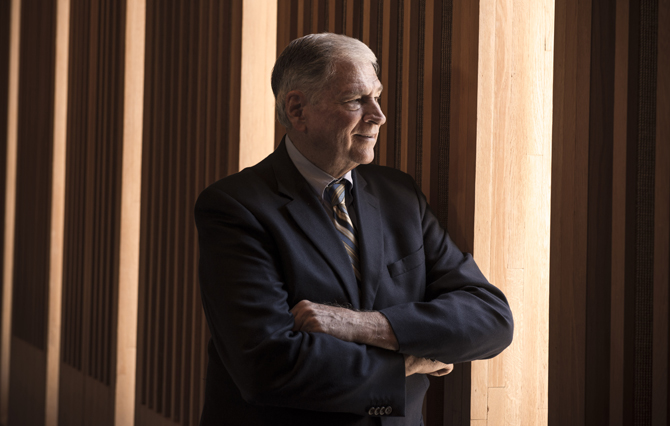Updated: In 2014, William G. Enright stepped down as executive director to become a senior fellow at the Lake Institute on Faith & Giving.
The recession offers an opportunity for Christian leaders to break their silence on talk about money, said William G. Enright, executive director of the Lake Institute on Faith & Giving at the Lilly Family School of Philanthropy at Indiana University-Purdue University Indianapolis.
 Evidence suggests that American congregations can be divided roughly into three categories, Enright said: one-third who haven’t been affected much by the recession, one-third whose budgets have remained the same, and one-third whose budgets have shrunk.
Evidence suggests that American congregations can be divided roughly into three categories, Enright said: one-third who haven’t been affected much by the recession, one-third whose budgets have remained the same, and one-third whose budgets have shrunk.
But even those who are faring well should be careful, as trends show that religious giving has declined as a percentage of overall philanthropy and that “devout donors” may be motivated by faith but don’t necessarily give to religious institutions.
The lesson, Enright said, is to tell a story of transformation rather than just ask for money. “Increasingly, people want to know, ‘What difference does my gift make?’” he said.
Enright, who is the former senior pastor of Second Presbyterian Church in Indianapolis, Ind., spoke with Faith & Leadership about the effects of the recession on religious philanthropy.
Q: Three and a half years after the beginning of the recession, how are congregations doing?
We do a lot of work with congregations, and we’ve looked at a lot of studies, and it seems to me that we find that about maybe a third, a little over a third of the congregations say that they really haven’t been affected by this. About a third will say their budgets stayed the same, and another third or so will say that their budgets are declining.
It’s a bit of an oversimplification, but it generally fits, I think.
It has certainly been a belt-tightening time for congregations. We did some work on what we called tipping points -- three tipping points as predictors of the degree to which the recession might be affecting you.
One was if a congregation had an endowment, the degree to which they are reliant on the endowment for their annual operational budget.
The second predictor, we felt, was debt repayment: if the church had had a mortgage or if the congregation had debt repayments. We talked to a lot of people, and we said that if your debt repayment exceeds 4 to 5 percent of your operational budget, there’s a good probability that you have been adversely affected by the recession.
Then, of course, there’s what we just called the local demographic issues. Different parts of the country have been much more seriously affected than others, and that can even get down into local communities, depending on the congregants within a congregation.
Q: What’s at stake in these conversations about money? What are those religious and ethical downstream effects beyond just the survivability of the institution?
In the Christian tradition, Jesus had as much to say about money, even more, than any other subject -- that and the kingdom of God. He talked about money. He raised provocative questions about how do we use the possessions that we have.
What we observe is that in too many congregations those issues have not been raised. There has not been talk about what it means to be a good steward.
What does it mean to manage with integrity the resources that you have? Churches have not really been addressing that issue. I think the silence of the churches on what I would call “money talk” has had profound cultural effects.
The question that I’ve often asked myself is, “What if, for the last generation or two, the church had been more faithful talking about what does it mean to be a faithful steward of your resources? Would that have altered at all the economic predicament in which we now find ourselves?”
Sitting behind that there are ethical issues and concerns. What does it mean to be generous? How does one nurture this virtue of generosity, which is certainly pivotal to living a faithful life?
Money is like a vital sign of the much deeper issue of the health and vitality of a faith community. There’s certainly, sadly, the history that we Christians can be victimized by greed like anyone else. Or you’re just trying to keep an institution alive.
But really, how are you using your funds for the greater good, for reaching out and making a difference in the community?
Q: Are these indicators about long-term sustainability, or are they specific to the recession?
We think those are long-term sustainability questions. In fact, one of the things that we say is we don’t think that the recession told congregations anything particularly new. It just put on the front page what congregations were wanting to ignore: we are in a serious time of economic challenge.
When we look at the data we have from our own center, if you look at about 1970 to about 1995 and if you look at all charitable giving, giving to religion was roughly half of all charitable dollars. Since 1995, what was one-half has now become one-third.
I was looking at a report that recently came out from Hartford Seminary, and one of their questions is about congregations reporting their own financial health. It gave an interesting comparative figure. In 2000, 31 percent in their survey of congregations described their financial health as excellent; in 2010, the percentage was 14.
Q: I know those are big questions, and people can lose sight of that if the roof is leaking.
When a church has to decide, “Do we repair our roof or do we cut a mission?” that’s a tragic moral choice.
Q: You mentioned this rule of thumb about financial health: one-third, one-third, one-third. What were the surprises as you looked at the numbers?
It was the megachurches that were making the headlines across America. For example, you had Saddleback, which laid off people. Of course, you have the story of the Crystal Cathedral that has filed for bankruptcy. In our own state here, in Indiana, we had the stories of that from a number of very large megachurches. They made the headlines.
What didn’t make the headlines was the average church in America, how they were coping with the recession. They have been struggling, many of them, for some time, and certainly the recession has intensified their struggle.
I think the second thing that struck us was that -- we allowed for anecdotal comments, and it was really moving to us to find the commitment and dedication among clergy. In many, many congregations, clergy had taken salary cuts or had not taken any pay increases. If they had to make cuts, they were trying to cut back on some things that might be considered more programmatic and administrative.
But the last thing they wanted to cut were their outreach programs to the community, meeting human need. We thought that was really a story to celebrate, about the sacrifice that is there with many clergy and congregations in the midst of the recession.
Q: Are you getting any kind of anecdotal responses about how people are feeling now, several years in?
Well, we’re always asked, “What’s the prognosis for the future?” We have to be careful, but it is really interesting when -- if you look at Giving USA this year, where they took the data from 1970 through 2009 to 2010 -- when you look at the giving in terms of the gross domestic product, you find that from about the 1970s on, that dips down. ’74 on it dips down; it’s about 1.7 percent. And then it pops up in the mid-’90s, to 2.2 percent.
Well, we have this moment of economic boom in one sense. So you’re riding on from 1.7 percent in terms of total giving as a percentage of the GDP to 2.2. Then it dipped down in 2009 to 2.1.
So from ’95 to 2008 -- was that an exception, or is that a new norm? Are things going to be going back to where they were more in the ’80s and ’90s and ’70s? We can’t answer that question, but we say we think that you really do need to be cautious.
Another thing that we would say with congregations is that the competition has increased significantly. In the last 15 years, the number of faith-based nonprofits has increased. So that means that there’s much more competition for that religious piece of the pie.
Q: So there may be religious giving, but it’s not going to the congregation?
Right. And as people talk about their giving, if you look at -- we’ve got some studies done on donor profiles. If you look at what we call the “devout donor” profile, 29 percent of their [donated] dollars go to religion, but 90 percent of their giving is driven and motivated by their religious and spiritual values.
So, in other words, they might be giving to a homeless shelter driven by their spiritual values, but that’s not considered religious giving.
We think a key is learning to tell a story of transformation rather than just asking for money. Increasingly, people want to know, “What difference does my gift make?”
We also have some work, by the way, that underscores that. What at least intrigued me was the Bank of America Merrill Lynch 2010 Study of High Net Worth Philanthropy, which compared data from 2007 to 2009, and one of those questions was, “Why do you give? What are your motivations for giving?”
The No. 1 motivation in 2007 for high-net-worth families was to give back to the community. The No. 1 motivation in 2009 -- it was a significant shift -- was to give to those programs that are really making a difference.














